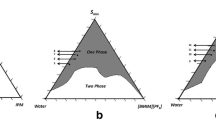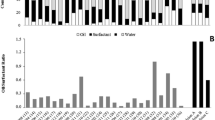Abstract
The purpose of this research was to develop the pseudo-ternary mixing diagrams for a potential drug delivery system consisting of vitamin E (potential drug) + soybean oil + surfactant + co-surfactant (anhydrous glycerol) + water. The potential drug (vitamin E) was loaded in the oil phase. The effects of different surfactants (pure and mixed) on the mixing diagrams, especially on the nanoemulsion region, were investigated. The influence of the drug loading level on the mixing diagrams was also determined. The surfactants studied were polyethoxylated (20) sorbitan monolaurate, polyethoxylated (20) sorbitan monooleate, polyethoxylated (35) castor oil and their mixtures. The size (area) of the nanoemulsion region of the mixing diagrams was found to be dependent on the type of surfactant used and the loading level of the drug (vitamin E).
















Similar content being viewed by others
References
Han SF, Yao TT, Zhang XX, Gan L, Zhu C, Yu HZ, Gan Y (2009) Lipid-based formulations to enhance oral bioavailability of the poorly water-soluble drug anethol trithione: effects of lipid composition and formulation. Int J Pharm 379:18–24
Burcham DL, Maurin MB, Hausner EA, Huang SM (1997) Improved oral bioavailability of hypocholesterolemic DMP in dogs following dosing in oil and glycol solutions. Biopharm Drug Dispos 18:737–742
Serajuddin ATM, Shee PC, Mufson D, Bernstein DF, Augustine MA (1988) Effect of vehicle amphiphilicity on the dissolution and bioavailability of a poorly water-soluble drug from solid dispersion. J Pharm Sci 77:414–417
Schwendener RA, Schott H (1996) Lipophilic 1-beta-d-arabinofuranosyl cytosine derivatives in liposomal formations for oral and parenteral antileukemic therapy in the murine L1210 leukemia model. J Canc Res Clin Oncol 122:723–726
Gursoy RN, Benita S (2004) Self-emulsifying drug delivery systems (SEDDS) for improved oral delivery of lipophilic drugs. Biomed Pharmacother 58:173–182
Lovelyn C, Attama AA (2011) Current state of nanoemulsions in drug delivery. J Biomater Nanobiotechnol 2:626–639
Fernandez P, Andre V, Rieger J, Kuhnle A (2004) Nano-emulsion formation by emulsion phase inversion. Colloids Surf A 251:53–58
McClements DJ (2012) Nanoemulsions versus microemulsions: terminology, differences, and similarities. Soft Matter 8:1719–1729
Mason TG, Wilking JN, Meleson K, Chang CB, Graves SM (2006) Nanoemulsions: formation, structure, and physical properties. J Phys: Condens Matter 18:R635–R666
Humberstone AJ, Charman WN (1997) Lipid-based vehicles for the oral delivery of poorly water soluble drugs. Adv Drug Deliv Rev 25:103–128
Boonme P, Krauel K, Graf A, Rades T, Junyaprasert VB (2006) Characterization of microemulsion structures in the pseudoternary phase diagram of isopropyl palmitate/water/Brij 97:1-butanol. AAPS Pharm Sci Tech 7:E99–E104
Sing AJF, Graciaa A, Lachaise J, Brochette P, Salager JL (1999) Interactions and coalescence of nanodroplets in translucent O/W emulsions. Colloids Surf A 152:31–39
Li P, Ghosh A, Wagner RF, Krill S, Joshi YM, Serajuddin ATM (2005) Effect of combined use of nonionic surfactant on formation of oil-in-water microemulsions. Int J Pharm 288:27–34
Gey KF, Brubacher GB, Stahelin HB (1987) Plasma levels of antioxidant vitamin in relation to ischemic heart disease and cancer. Am J Clin Nutr 45:1368–1377
Julianto T, Yuen KH, Noor AM (2000) Improved bioavailability of vitamin E with a self emulsifying formulation. Int J Pharm 200:53–57
Gelderblom H, Verweij J, Nooter K, Sparreboom A (2001) Cremophor EL: the drawbacks and advantages of vehicle selection for drug formulation. Eur J Cancer 37:1590–1598
Sarpotdar PP, Zatz JL (1986) Percutaneous absorption enhancement by non-ionic surfactants. Drug Dev Ind Pharm 12:1625
Rigg PC, Barry BW (1990) Shed snake skin and hairless mouse skin as model membranes for human skin during permeation studies. J Invest Dermatol 94:235–240
Williams AC, Barry BW (2004) Penetration enhancers. Adv Drug Deliv Rev 56:603–618
Pershing LK, Lambert LD, Knutson K (1990) Mechanism of ethanol enhanced estradiol permeation across human skin in vivo. Pharm Res 7:170–175
Oh DH, Balakrishnan P, Oh YK, Kim DD, Yong CS, Choi HG (2011) Effect of process parameters on nanoemulsion droplet size and distribution in SPG membrane emulsification. Int J Pharm 404:191–197
Kang BK, Lee JS, Chon SK, Jeong SY, Yuk SH, Khang G, Lee HB, Cho SF (2004) Development of self-microemulsifying drug delivery systems (SMEDDS) for oral bioavailability enhancement of simvastatin in beagle dogs. Int J Pharm 274:65–73
Salager JL, Morgan JC, Schechter RS, Wade WH, Vasquez E (1979) Optimum formulation of surfactant/water/oil systems for minimum interfacial tension or phase behavior. Soc Petrol Eng J 19:107–115
Acosta EJ, Yuan JS, Bhakta AS (2008) The characteristic curvature of ionic surfactants. J Surf Deterg 11:145–158
Acosta EJ (2008) The HLD–NAC equation of state for microemulsions formulated with nonionic alcohol ethoxylate and alkylphenol ethoxylate surfactants. Colloids Surf A 320:193–204
Davies R, Graham DE, Vincent B (1987) Water-cyclohexane-“Span 80”-“Tween 80” systems: solution properties and water/oil emulsion formation. J Colloid Interface Sci 116:88–99
Griffin WC (1954) Calculation of HLB values of non-ionic surfactants. J Soc Cosmet Chem 5:259
Desai N, Yao Z, Trieu V, Soon-Shiong P, Dykes D, Noker P (2003) Evidence of greater tumor and red cell partitioning and superior antitumor activity of Cremophor free nanoparticle paclitaxel (ABI-007) compared to taxol. Breast Cancer Res Treat 82(suppl 1):S83. Abstract 348
Goss KU, Schwarzenbach RP (2003) Rules of thumb for assessing equilibrium partitioning of organic compounds: successes and pitfalls. J Chem Educ 80:450–455
Noureddini H, Teoh BC, Clements LD (1992) Viscosities of vegetable oils and fatty acids. J Am Oil Chem Soc 69:1189–1191
Vitamin E TPGS NF and food grade. ISOCHEM. Les Créations Philippe Toumire
Acknowledgments
Financial support for this research is provided by NSERC in the form of a discovery grant awarded to Professor Rajinder Pal.
Author information
Authors and Affiliations
Corresponding author
About this article
Cite this article
Wang, Z., Pal, R. Enlargement of Nanoemulsion Region in Pseudo-ternary Mixing Diagrams for a Drug Delivery System. J Surfact Deterg 17, 49–58 (2014). https://doi.org/10.1007/s11743-013-1497-6
Received:
Accepted:
Published:
Issue Date:
DOI: https://doi.org/10.1007/s11743-013-1497-6




